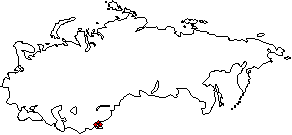CONTENTS
IntroductionForeword
Language Groups
Tribes and Dialects
Order the book
The Peoples
of the Red Book
Abazians (Abaza)Abkhaz
Aguls
Akhvakhs
Aleuts
Altaics
Aliutors
Andis
Archis
Asiatic Eskimos
Bagulals
Baraba Tatars
Bartangs
Bats
Bezhtas
Botlikhs
Budukhs
Central Asian Jews
Chamalals
Chukchis
Chulym Tatars
Crimean Jews
Crimean Tatars
Didos
Dolgans
Enets
Evens
Evenks
Georgian Jews
Godoberis
Hinukhs
Hunzibs
Ingrians
Ishkashmis
Itelmens
Izhorians
Kamas
Karaims
Karatas
Karelians
Kereks
Kets
Khakass
Khants
Khinalugs
Khufis
Khvarshis
Kola Lapps
Koryaks
Kryz
Kurds
Lithuanian Tatars
Livonians
Mansis
Mountain Jews
Nanais
Negidals
Nenets
Nganasans
Nivkhs
Nogays
Orochis
Oroks
Oroshoris
Peoples of the Pamirs
Roshanis
Rutuls
Selkups
Shors
Shughnis
Tabasarans
Talysh
Tats (Tatians)
Tindis
Tofalars
Trukhmens (Turkhmens)
Tsakhurs
Udeghes
Udis
Ulchis
Veps
Votes
Wakhs
Yaghnabis
Yazgulamis
Yukaghirs
visit the guestbook or mail comments to the webmaster

THE ROSHANIS
Habitat. The Roshanis live in the Pamirs in the Roshani District of the Gorno-Badakhshan Autonomous Region of the Tadzhik SSR, north of the Shughni domain. The centre is Kalai-Vomar, also called Roshan. The Roshani-speaking villages are situated on the right bank of the Pyandzh River between the villages of Akhdzev (Yakhdzev) and Shipad. Roshani is also spoken in the villages of the lower Bartang (Yemts, Baghu and Rid). In the 1950s about one hundred Roshani families were resettled to the Djilikul and Kumsagir villages in the Vakh valley, despite the fact that natural conditions in Roshani are conducive to agriculture -- sufficient arable land as well as orchards and good pastures exists.
Population. Data concerning the Roshani population is to be found in the official list of the towns and villages in the Tadzhik SSR (Stalinabad 1932) -- there were 5838 inhabitants in Roshan, including 653 in the village of Khufi and 424 in Baju. According to A. Dyakov, about 2000 to 3000 people lived in Afghanistan's Roshan on the left bank of the River Pyandzh. According to records from 1939, 5300 Roshani lived in the Tadzhik SSR.
Language. The Roshani language belongs to the Shughni-Roshani subgroup of the Pamir group of the Iranian branch of Indo-European languages, and dialects of this subgroup understand each others' speech without any notable difficulties. With other speakers of the Pamir languages -- the Yazgulami, the Wakhis, the Ishkashmi -- communication is based on Tadzhik in Tadzhikistan and Afghanistan and on Uighur in China. The Roshani language exists only in spoken form; textual examples are scarce. The relation between Roshani and Bartangi is complex and facilitates smooth shifts from one to the other in communication.
In 1916 a short article by R. Gauthiot was published containing Bartangi and Roshani words. Before that the Roshani were known in Europe only by name. The first textual example -- a fairy tale -- appeared in a study by W. Lentz (Pamir-Dialekte. Materialen zur Kenntniss der Schugni-gruppe, Göttingen 1933, pp. 101--105). Roshani and Bartangi are formally close to Oroshori, contrasting with Shughni.
The Roshani have preserved their language comparatively well (1959), Shughni influence being almost non-existent. Tadzhik influence is detectable in certain lexical areas. For example, in discussing politics Tadzhik expressions and grammatical constructions appear.
Roshan's most important villages are Barukhshan (Barushon) and Derzud (Dirzut). The villages are situated 3--4 kilometres apart and so communication between the inhabitants is quite easy. The people of either village speak a somewhat different form of Roshani, the divergence, however, being negligible. Lexical differences are few.
History. In the past, the Roshani and the Khufi practised a rather original form of co-operation. After ploughing their fields the Roshani sent their oxen for a stipulated fee to the upper villages in the Khufi valley where spring ploughing could be started a month later. In the 1950s the Roshani of the upper villages, like Bartangi, Oroshori and Yazgulami, were made to resettle on the cotton plantations of the Vakhsh valley.
REFERENCES
- H. Sköld, Materialen zu den Iranischen Pamirsprachen, Lund 1936
- А. М. Дьяков, Языки советского Памира. -- Культура и письменность Востока. Т. 1, Москва 1931
- И. И. Зарубин, Бартангские и рушанские тексты и словарь, Москва -- Ленинград 1937
- А. К. Писарчик, Рушанские тексты, Сталинабад -- Ленинград 1954
- В. С. Соколова, Рушанские и хуфские тексты и словарь, Москва -- Ленинград 1959
- М. Фейзов, Язык рушанцев Советского Памира, Душанбе 1966
LV
pamir_peoples | roshanis | rutuls